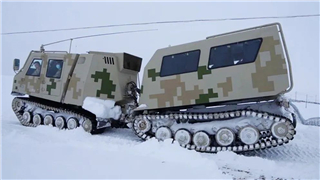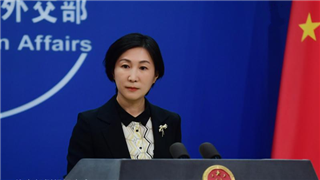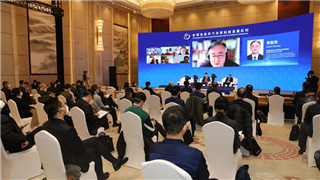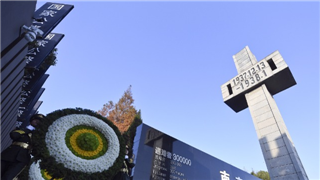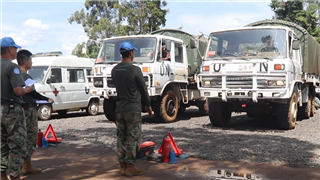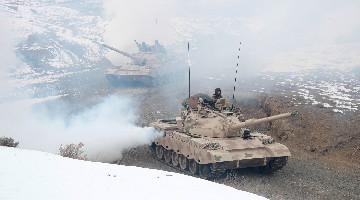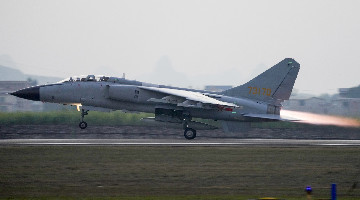By Li Jiabao
According to foreign media reports, the US new-generation strategic bomber B-21 Raider recently made a high-profile appearance. B-21 Raider is a long-range stealth strategic bomber capable of carrying nuclear weapons and serves as the first achievement of the US$ 1.2 trillion nuclear arms expansion plan. As one of the measures taken by the US to expand its nuclear arsenal and hype up the competition among major powers, this move is bound to bring great risks to global security and strategic stability.
America's frequent moves to "expand nuclear arms"
In recent months, the US government has released a series of documents including the National Security Strategy (NSS), and the 2022 Nuclear Posture Review (NPR), which makes clear the Biden administration's nuclear strategy.
At the same time, the US has taken multiple measures and moves to keep upgrading its nuclear arsenal. It has accelerated the deployment of new tactical nuclear weapons B61-12 to several NATO bases in Europe and upgraded its nuclear arsenals in Europe. The US has also planned to establish a small-scale multilateral nuclear consultation mechanism with Japan, the ROK and Australia in the Indo-Pacific region to share nuclear intelligence and even considered copy the European model to deploy strategic bombers, dual-capable aircraft and related nuclear weapons to the frontline in the Indo-Pacific region.
In this regard, Guo Xiaobing, Director of the Center for Arms Control Studies, China Institutes of Contemporary International Relations, pointed out that from the multiple documents issued and moves taken by the Biden administration, the US has currently planned to implement integrated deterrence, maintain a low threshold for the application of weapons, promote the upgrading of nuclear arsenals, emphasize the construction and development of nuclear weapons infrastructure, highlight its so-called "limited nuclear war" to develop and deploy low yield nuclear warheads while strengthening extended deterrence, and reinforce the “Indo-Pacific” nuclear sharing mechanism and the forward deployment of strategic forces.
Hyping up major power competition
The US Department of Defense recently released its 2022 Military and Security Developments Involving the People's Republic of China, also known as China Military Power Repor t, which has made wild guesses and comments on China's military modernization, claiming that "China currently has more than 400 nuclear warheads, which will increase to 1,000 in 2030, and 1,500 in 2035".
"The data released in this report by the US are very unserious. It is not a calculation based on proven data or any inference method, but purely a deliberate fabrication to hype up the so-called 'China's nuclear threat'." Guo Xiaobing pointed out that, the move taken by the US is aimed at covering up its disgraceful actions in the area of nuclear arms control and non-proliferation, and trying to make black white and putting pressure on China to limit its normal military power development.
Li Haidong, a professor at the Institute of International Relations of China Foreign Affairs University, also pointed out that the US has the most advanced nuclear arsenals in the world, yet it still continues to create excuses for expanding its arsenals, by hysterically hyping up the external nuclear threats and forging an "imaginary enemy". This is not convincible even to the least extend. The nuclear issue concerns major power relations and global strategic balance and stability. The US moves are bound to push its foreign policy and nuclear strategy to the influence of its domestic military industry interest groups, exacerbating its competitive situation with China and threatening global security and strategic stability.
Intensifying risks of nuclear conflicts
Guo believed that the current US nuclear policy has blurred the boundary between nuclear weapons and conventional weapons, actually increasing the probability for US to use nuclear weapons in local conflicts, enhancing the risks of nuclear war, and adding great uncertainty to the global security situation.
Many experts in arms control also expressed serious concerns. Daryl G. Kimball, Executive Director of the US Arms Control Association, commented that the broad and ambiguous policy as mentioned in the 2022 NPR has been a violation of the US' commitment to reducing the role of nuclear weapons in its NSS. Tara Drozdenko, Director for the Global Security Program at the Union of Concerned Scientists, pointed out that the 2022 NPR has strengthened the nuclear threat, with its function more like a "rubber stamp" of the US nuclear military industrial complex.
Li pointed out that one of the US's main thinking in the field of nuclear arms control lies in highlighting the absolute advantage of the US in the compilation of relevant mechanisms and agreements. Out of the reason, the US has been acting passively in the international arms control framework in recent years, having successively withdrawn from multiple international arms control treaties including the Treaty on the Limitation of Anti-Ballistic Missile Systems (ABM Treaty), and the Intermediate-Range Nuclear Forces Treaty (INF Treaty). What the US is pursuing is not the common security of the international community; instead, it has been seeking absolute security for itself. Guided by this thinking, the US has been vigorously expanding its nuclear arsenals and hyped up threats from major powers, with a view to compressing the strategic choices of its allies and partners without bringing them real security, while aggravating the risks of the global arms race and making the world more insecure.
Editor's note: Originally published on haiwainet.cn, this article is translated from Chinese into English and edited by the China Military Online. The information and opinions in this article do not necessarily reflect the views of eng.chinamil.com.cn.
